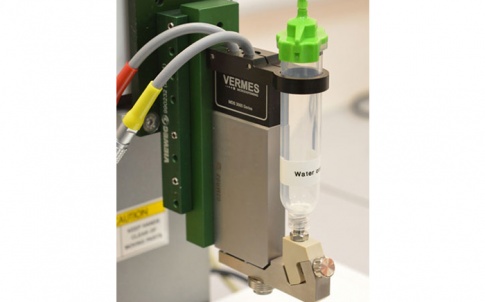
Two non-contact jetting valves for low and medium viscosity liquids have been launched in the UK by Intertronics.
The Vermes MDS 3010+ and Vermes MDS 3020+ microdispensing jetting valves are designed for precision dispensing of material in small volumes at fast speeds with extremely high accuracy and repeatability. The piezo-actuated valves satisfy the trend for increasing miniaturisation of components in production processes – demanding ever-smaller deposits of beads and lines – as well as the requirement to dispense on 3D shapes, inside assemblies and other irregular applications.
The MDS 3010+ is suitable for jetting liquids up to 300 mPas viscosity, such as aqueous fluids, UV adhesives, cyanoacrylates, anaerobic glues and a host of other media. The MDS 3020+ is designed for fluids up to 8,000 mPas including medium-viscosity adhesives, organic solvents, lacquers, solder fluxes, oils and greases. Both models feature repeatable dot or bead dispensing in volumes as low as 5 nl per pulse, with a minimum droplet diameter of 300 µm, depending on the medium, and a maximum frequency greater than 3,000Hz.
The Vermes systems are likely to find applications in a wide range of sectors including microelectronics, micromechanics, life sciences, medical diagnostics and pharmaceutical laboratories.
Intertronics Managing Director Peter Swanson says: “This ultra-fast, super accurate and fully repeatable dispensing enables companies to save time, reduce waste and dispense materials in locations not possible with other methods – such as inside components, following 3D shapes. They can even deposit variable width lines, dots and complex patterns upside down.”
Other benefits include multiple customisable configurations, easy cleaning to reduce downtime and integral real-time fault and stoppage monitoring.
For further information please see www.intertronics.co.uk/vermes-3010 or visit the Intertronics blog at www.intertronics.co.uk/blog.










Radio wave weapon knocks out drone swarms
Probably. A radio-controlled drone cannot be completely shielded to RF, else you´d lose the ability to control it. The fibre optical cable removes...